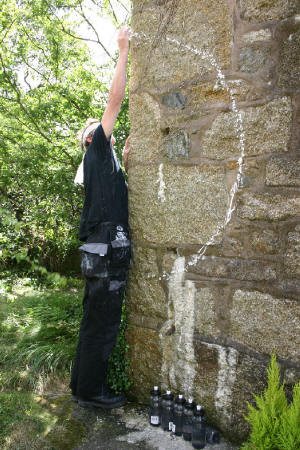| artcornwall | ||
| home | features | exhibitions | profiles | gazetteer | links | archive | ||
|
'Modernism' v 'post-modernism': new directions for Cornish art?
During the last 100 years Cornwall has contributed a disproportionate amount to the artistic heritage of Britain. The two most important ‘modernist’ schools of painting in Newlyn and St Ives were, in their time, at the cutting edge of taste in the visual arts, and their legacies have loomed large over subsequent generations of Cornish artists. Though out-of-step with subsequent developments in the international art world, painting derived from one of these two schools has remained the dominant idiom adopted by artists working in the county. This is reflected in the regular shows mounted by the Penwith and Newlyn Society of Artists, the latter of which especially has close links with local commercial galleries. In some respects this scenario is unique to Cornwall
but in others it is not. Paintings as unique hand-crafted objects have
remained highly marketable, particularly for a domestic market, and
especially when they depict inoffensive and reassuring subject matter such
as the landscape. This style of art has been relatively easy to sell
because it conforms to the public’s idea of what art should be. In
addition it can be linked to romantic ideas of the artist as ‘genius’,
displaying his presence in the work through his mark-making and unique
vision of the world. This ‘genius’ ultimately confers extra market-value
to the work, which by definition has a ‘signiature style’. The modernist art of the early part of the century, including that of Newlyn and St Ives, was very much a part of this orthodoxy. The grip that modernism has had on art in Cornwall seems to lessen by the year, however, such that less obviously commercial ‘post-modern’ art practices are increasingly taking centre-stage. Although this term is very imprecise, it is convenient in the context of the Cornish art scene, and can here be taken to refer to art that is recognisable by its links to conceptual art, land art, performance and installation art, and the use of contemporary media like photography. These approaches have in common a more tenuous relationship with the art-market, in that the art is less obviously a commodity to be bought and sold. They are also more likely to problematise the notion of the artist’s unique vision as the origin of the work, seeking instead to develop the work from within a wider network of historical and cultural relationships. Until recently there does not seem to have been a
critical mass of artists and audience in Cornwall interested in overtly
post-modern visual art as defined above. Following attempts by artists
groups like P.A.L.P. (Penwith Artist-led Projects) and Art-surgery
starting in the 90s, in the last couple of years the trickle away from the
legacy of modernism in Cornwall has become a flood. One sign of this
gathering momentum is the support given to such work by commercial
galleries in the county like Vitreous Contemporary Art and The Salt
Gallery, that recognise the importance of engaging a younger audience who
do not closely identify with older local traditions. Another is the
catalytic effect of Transition (picture above top): an annual
exhibition at the Newlyn Gallery that has helped foster a progressive
attitude amongst local artists who have shown there.
This general movement may continue as artists become more confident about putting on their own shows and where necessary, working outside conventional institutional constraints. Two artist-led exhibitions this summer provided proof that this is a worthwhile and effective strategy for taking new art to new audiences in Cornwall. Both were ambitious and successful, but neither included painting. Indeed neither seemed to acknowledge or be particularly interested in the artistic heritage of Cornwall, and instead drew on international developments in art practice subsequent to the modernist period. Called ‘Wheal Art Weekend’ and ‘eek’, the two shows were different in as much as the former (picture right) was sited in a disused mine, and the pieces chosen for inclusion were very much a response to the site. The latter (picture below left) was in an old grammar school, and whilst attuned to its setting, the pieces that were included were not ‘site-specific’ in the same way. In addition eek, perhaps significantly, mixed artists from Cornwall with artists from London. Whilst these shows are symptomatic of a new-found confidence, they also seem to highlight a number of issues. Firstly post-modernist art as defined above is around 40 years old, and whilst it offers a powerful alternative to traditional forms of painting, it is not automatically more original, interesting or progressive. Secondly, Cornish artists will have to be wary of simply copying the look of art from London or New York. Doing so is likely to be doomed to failure, as they will always tend to follow the trends rather than lead them, and therefore play second fiddle to artists in the larger cities. Thirdly even the most progressive work has to retain a level of institutional support, in the form of supportive gallery spaces, and sympathetic critics and buyers.
But the other key ingredient will be for artists in Cornwall to share visual ideas, and work with each other to develop a visual language that is strong, confident and distinctive, and removed but not completely detached from the artistic heritage of the county. A complete break with the past would be a mistake. The belatedly sustained engagement of Cornish artists with international post-modern art will produce something that is authentic and original only if it can retain a dialogue with the best of what has come before.
Rupert White August 2006
|
2retouched_small.jpg)

